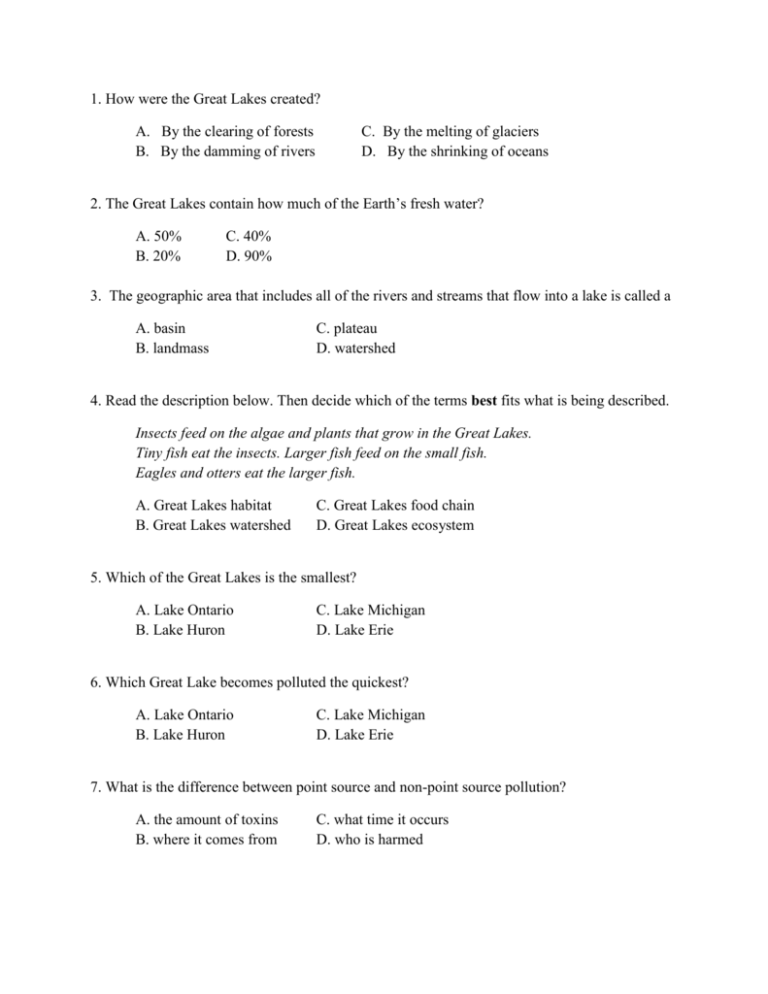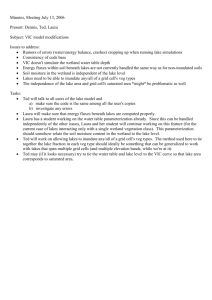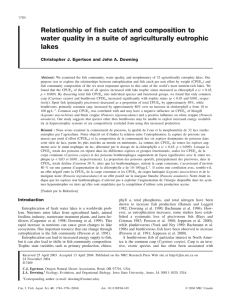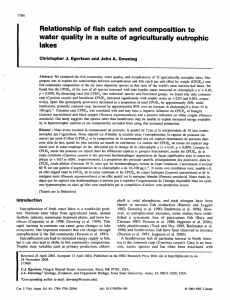Great Lakes Test
advertisement

1. How were the Great Lakes created? A. By the clearing of forests B. By the damming of rivers C. By the melting of glaciers D. By the shrinking of oceans 2. The Great Lakes contain how much of the Earth’s fresh water? A. 50% B. 20% C. 40% D. 90% 3. The geographic area that includes all of the rivers and streams that flow into a lake is called a A. basin B. landmass C. plateau D. watershed 4. Read the description below. Then decide which of the terms best fits what is being described. Insects feed on the algae and plants that grow in the Great Lakes. Tiny fish eat the insects. Larger fish feed on the small fish. Eagles and otters eat the larger fish. A. Great Lakes habitat B. Great Lakes watershed C. Great Lakes food chain D. Great Lakes ecosystem 5. Which of the Great Lakes is the smallest? A. Lake Ontario B. Lake Huron C. Lake Michigan D. Lake Erie 6. Which Great Lake becomes polluted the quickest? A. Lake Ontario B. Lake Huron C. Lake Michigan D. Lake Erie 7. What is the difference between point source and non-point source pollution? A. the amount of toxins B. where it comes from C. what time it occurs D. who is harmed 8. Runoff is when rain, snow, and irrigation water pick up___________ from the soil. A. Rocks B. Seeds C. Pollutants D. Insects 9. A sewage pipe emptying into a lake is an example of: A. Air pollution B. Land pollution C. Non-point source pollution D. Point-source pollution 10. Which of the following suffered the most from DDT poisoning in the Great Lakes? A. Fish-eating birds B. large fish C. small fish D. tiny organisms 11. What is the best way to deal with pollution? A. Treat it C. Create it B. Prevent it D. Ignore it 12. How do sea lampreys and zebra mussels enter the Great Lakes? A. In ballast water B. On boats C. Swimming D. All of the above 13. Non-native plants and animals that move into a new ecosystem are called A. Native species B. New species C. Invasive species D. Hybrid species 14. The sea lamprey and zebra mussel are examples of A. wetland loss B. invasive species C. algae explosions D. point-source pollution 15. Alewife population is declining because of the introduction of which fish in the Great Lakes? A. Tuna B. Marlin C. Carp D. Salmon 16. Which invasive species is a parasite that sucks blood from native fish? A. Sea Lamprey B. Zebra mussel C. Asian Carp D. Purple loosestrife 17. How do zebra mussels cause problems? A. They clog water pipes C. Make swimming dangerous from sharp shells B. They steal food from fish D. All of the above. 18. How do Asian carp pose threats to humans? A. They eat native fish B. They damage boats C. They hit people D. All of the above 19. Which invasive species poses the highest threat to native plants? A. Purple loosestrife C. Zebra mussel B. Sea lamprey D. Asian carp 20. There are currently more than______invasive species in the Great Lakes. A. 50 B. 170 C. 150 D. 75 21. A swamp, bog, or marsh is an example of a A. Watershed C. Wetland B. Lake D. River 22. The development of housing and businesses creates A. Pollution B. Habitat loss C. Invasive Species D. Both A + B 23. What is a major reason for the growing water shortage? A. Invasive species B. Habitat Loss C. Shrinking glaciers D. Population growth 24. What causes algae to overgrow along the shorelines of the Great Lakes? A. E.coli in the water B. Detergents in the water C. Sewage in the water D. Fish in the water Read the following definitions. Choose the vocabulary term below that best fits the definition. Write the term on the blank space provided on the answer sheet. Ecosystem Freshwater Food Web Food chain Wetland Habitat 25. All of the feeding relationships within an ecosystem. 26. Made up of water that is fresh. 27. The natural environment in which a plant or animal lives 28. A community of all living things in an area and the environment in which they live. 29. An area of land with soil that is typically wet all year. 30. A series of plants and animals that depend on the one below it for food.











